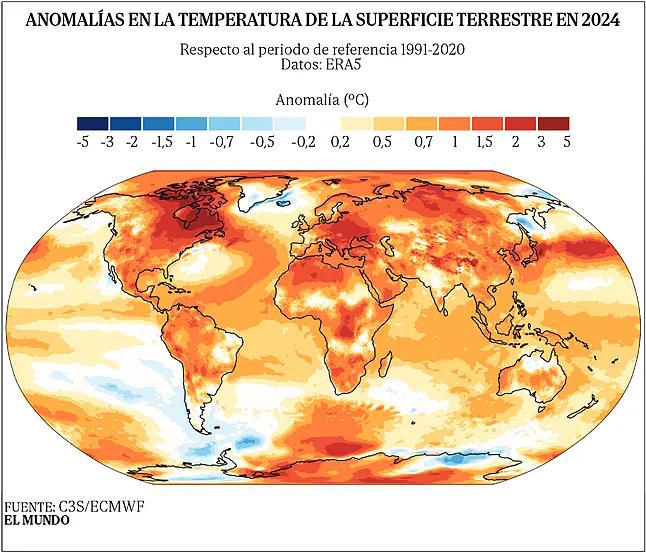2024 broke the heat record set in 2023, becoming the hottest year since 1850 when measurements began. This is confirmed by the annual report released by Copernicus Climate Change Service this Friday, which also highlights other records that make 2024 particularly negative in terms of the climate crisis.
It has also been a year with numerous extreme weather events worldwide, from severe storms and floods to heatwaves, droughts, and wildfires. In fact, both Copernicus' annual climate report and those from other organizations like NASA, NOAA, the World Meteorological Organization (WMO), and the UK Met Office - which will release their analyses throughout this Friday - come in the same week that California is experiencing one of its worst wildfires in history, fueled by strong winds, and large areas of the US are facing historic snowfalls.
According to the Copernicus report, prolonged dry periods in various regions of the world created favorable conditions for wildfires last year, which were particularly severe across the Americas. In terms of carbon emissions from wildfires, Bolivia and Venezuela recorded their highest levels ever, while Canada recorded its second-highest levels.
Regarding the heat record, the global average temperature was 15.10°C, which is 0.72°C higher than the 1991-2020 average, and 0.12°C higher than 2023, the year that previously held the record as the hottest since records began. On July 22, 2024, the daily global temperature record was also broken, reaching 17.16°C.
Another notable feature of the past year is that it was the first in which almost all its months, except for July, had a global average temperature exceeding 1.5 degrees compared to pre-industrial levels (globally, the average temperature in 2024 was 1.6 degrees higher than the 1850-1900 period).
From July 2023 to December 2024, all months except July 2024 exceeded the temperature increase limit that the international community had aimed not to exceed by the end of the century, an objective outlined in the 2016 Paris Agreement.
While surpassing this limit for a limited period like this is not good news for the fight against climate change, it does not mean that the Paris Agreement goal cannot still be achieved. As clarified by Copernicus scientists, for it to be considered breached, there must be temperature anomalies averaged over at least 20 years.
"The future is in our hands: swift and decisive action can still alter the course of our future climate," stated Carlo Buontempo, director of Copernicus Climate Change Service, emphasizing that "all internationally produced global temperature datasets show that 2024 was the hottest year since records began in 1850."
2024 has also been a year with numerous extreme weather events worldwide, from severe storms and floods to heatwaves, droughts, and wildfires. In fact, the release of these reports comes in the same week that the US is facing a devastating wildfire in California, fueled by strong winds, and intense snowfalls in other parts of the country.
Prolonged dry periods in various regions of the world created favorable conditions for wildfires last year, which according to the report, were particularly severe across the Americas. In terms of carbon emissions from wildfires, Bolivia and Venezuela recorded their highest levels ever, while Canada recorded its second-highest levels.
The main factor behind the unusually high temperatures recorded on land and sea surfaces during 2024 is human-induced climate change, but other factors, including the natural phenomenon of El Niño, have also contributed, as stated by the scientists who authored the Copernicus report.
In fact, following the trend from the second half of 2023 when El Niño effects were already noticeable, the average sea surface temperature in 2024 also set records, reaching 20.87°C, 0.51°C above the 1991-2020 average.
Furthermore, the Copernicus report highlights that last year, the total amount of water vapor in the atmosphere was the highest ever measured, being approximately 5% above the 1991-2020 average and 1% higher than in 2016 and 2023, the years that previously had the highest levels.
This data is significant as extreme temperatures and high humidity contribute to increased heat stress levels. Much of the northern hemisphere experienced more days than average with "extreme heat stress" during 2024, to the extent that on July 10, 2024, 44% of the planet was affected by strong or extreme heat stress, 5% higher than the annual maximum on average.
Additionally, the abundant moisture supply amplified the potential for heavy rainfall and, combined with high sea surface temperatures, contributed to the development of large storms, including tropical cyclones, making them more intense.
Regarding the concentration of greenhouse gases in the atmosphere, considered the main cause of global warming, both carbon dioxide and methane concentrations continued to rise in 2024: 422 parts per million (ppm) of CO2 and 1,897 parts per billion (ppb) of methane. This means that CO2 concentrations were 2.9 parts per million higher than in 2023, and methane levels were 3 parts per million higher.
The high temperatures also led to a decrease in sea ice in Antarctica and the Arctic, which is a key element in regulating the Earth's climate. After reaching record minimum values for the time of year during eight months of 2023, Antarctic sea ice extent again reached record or near-record minimum values for much of 2024. From June to October, the monthly extent was the second lowest, behind 2023, and the lowest for November.
Regarding the Arctic, sea ice extent was relatively close to its 1991-2020 average until July but fell well below average in the following months. At its annual minimum in September, the monthly extent ranked as the fifth lowest in satellite records.
